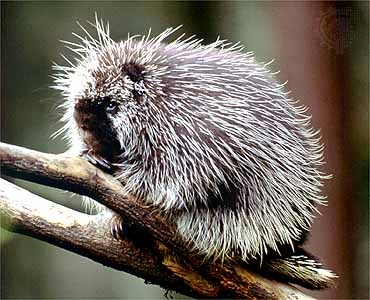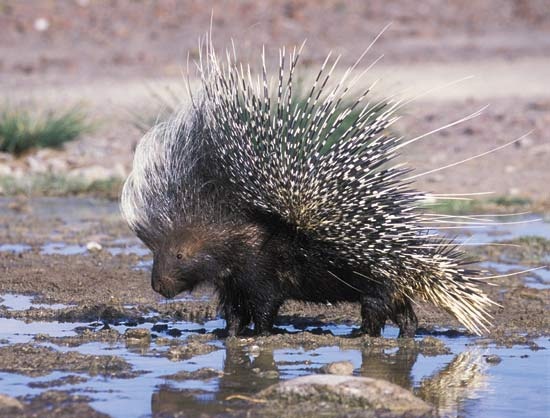porcupine
rodent
Introduction
 any of 25 species of large, herbivorous, quill-bearing rodents (rodent) active from early evening to dawn. All have short, stocky legs, but their tails range from short to long, with some being prehensile. The quills, or spines, take various forms depending on the species, but all are modified hairs embedded in skin musculature. Old World porcupines (Hystricidae) have quills embedded in clusters, whereas in New World porcupines (Erethizontidae) single quills are interspersed with bristles, underfur, and hair. No porcupine can throw its quills, but they detach easily and will remain embedded in an attacker. Base coloration ranges from grayish brown through dark brown to blackish, but this colouring is overlaid by variegated patterns of white, yellow, orange, or black due to bands on the spines.
any of 25 species of large, herbivorous, quill-bearing rodents (rodent) active from early evening to dawn. All have short, stocky legs, but their tails range from short to long, with some being prehensile. The quills, or spines, take various forms depending on the species, but all are modified hairs embedded in skin musculature. Old World porcupines (Hystricidae) have quills embedded in clusters, whereas in New World porcupines (Erethizontidae) single quills are interspersed with bristles, underfur, and hair. No porcupine can throw its quills, but they detach easily and will remain embedded in an attacker. Base coloration ranges from grayish brown through dark brown to blackish, but this colouring is overlaid by variegated patterns of white, yellow, orange, or black due to bands on the spines.New World porcupines (family Erethizontidae)
The North American porcupine (Erethizon dorsatum) is the largest species in the family, usually weighing less than 7 kg (15.4 pounds) though males occasionally grow significantly larger. Its body is up to 80 cm (31 inches) long, with a tail up to 30 cm. Both are covered with a total of 30,000 or more hollow quills. On the ground the porcupine ambles along and cannot jump; in the trees it climbs slowly but has excellent balance; in the water it swims well. When approached, the animal presents its rear. If attacked, it will drive its powerful, muscular tail against the assailant. Fishers (fisher), however, are able to prey upon porcupines by attacking their underside; bobcats and wolverines also are known to hunt porcupines successfully.
The North American porcupine inhabits forests, including wooded areas along rivers in tundra, grassland, and desert regions. Its range extends from Canada to northern Mexico, although it is absent from the southeastern United States. It is sometimes seen during the day, and it is the only New World porcupine that is terrestrial as well as arboreal. It will roost in trees but also dens in hollow trees, logs, or stumps, in addition to caves, rock crevices, burrows, or snowbanks. Individuals living in coniferous forests spend much time on the ground. Those living in deciduous and mixed forests, however, are more often seen in the trees, which are their source of food. During spring and summer, their diet includes buds, twigs, roots, stems, leaves, flowers, berries, seeds, and nuts. In winter, evergreen needles and the cambium layer and inner bark of trees become important sources of food. Bones and antlers are gnawed upon for calcium and other minerals. Although porcupines do not hibernate during the winter, they remain in their dens during especially cold or inclement weather. They are generally solitary but sometimes den in groups.
All other New World porcupines are arboreal, living in tropical forests (tropical rainforest) from southern Mexico to South America. Their muzzles are large and rounded. The stump-tailed porcupine, Echinoprocta rufescens, is one of the smallest at 37 cm plus a short tail. New World porcupines primarily eat fruit at night and rest during the day in hollow trees or crouch on branches or in tangles of woody vines. Their digits bear long, curved claws, and most species have long, muscular tails that can be curled upward and twisted around branches. Further improving the tail's grip are stiff bristles on the lower surface of the tail's tip (the upper surface is hairless). Still, like their northern relative, these tropical porcupines move slowly and are unable to jump, so they must descend to the ground to cross gaps between trees. The hollow quills of New World porcupines are sharp, stiff, and circular in cross section and have barbed tips. New World porcupines bear usually one young, sometimes two, after about 200 days' gestation.
Old World porcupines (family Hystricidae)
 Old World species are primarily terrestrial, although the long-tailed porcupine of Southeast Asia (Trichys fasciculata) also climbs in trees and shrubs for food. It is the smallest member of the family, weighing less than 4 kg, and is somewhat ratlike in appearance; it is about a half metre long, not including the tail, which is about half the length of the body. Brush-tailed porcupines (genus Atherurus) move swiftly over the ground and can climb, jump, and swim. They sometimes congregate to rest and feed. Brush- and long-tailed species shelter in tree roots, hollow trunks, rocky crevices, termite mounds, caves, abandoned burrows, or eroded cavities along stream banks. Short-tailed porcupines (genus Hystrix) are the largest, weighing up to 30 kg, with bodies almost a metre long and a tail 8–17 cm long. They move slowly in a ponderous walk but will break into a trot or gallop when alarmed. Like the North American porcupine, they gnaw antlers and bones to supplement their herbivorous diet, which includes the underground portions of plants, fallen fruits, and cultivated crops in addition to bark. Often sheltering in holes, rock crevices, or aardvark burrows, Hystrix species also excavate burrows of their own that can become extensive over years of occupation. European populations of the African crested porcupine (Hystrix cristata) retreat into their dens during storms and cold spells, but they do not hibernate. This species lives in Italy and Sicily, where it may have been introduced by man, and in Britain, where it was certainly introduced. Old World porcupines bear a litter of one to four (two are usual) after a gestation of approximately 100 days.
Old World species are primarily terrestrial, although the long-tailed porcupine of Southeast Asia (Trichys fasciculata) also climbs in trees and shrubs for food. It is the smallest member of the family, weighing less than 4 kg, and is somewhat ratlike in appearance; it is about a half metre long, not including the tail, which is about half the length of the body. Brush-tailed porcupines (genus Atherurus) move swiftly over the ground and can climb, jump, and swim. They sometimes congregate to rest and feed. Brush- and long-tailed species shelter in tree roots, hollow trunks, rocky crevices, termite mounds, caves, abandoned burrows, or eroded cavities along stream banks. Short-tailed porcupines (genus Hystrix) are the largest, weighing up to 30 kg, with bodies almost a metre long and a tail 8–17 cm long. They move slowly in a ponderous walk but will break into a trot or gallop when alarmed. Like the North American porcupine, they gnaw antlers and bones to supplement their herbivorous diet, which includes the underground portions of plants, fallen fruits, and cultivated crops in addition to bark. Often sheltering in holes, rock crevices, or aardvark burrows, Hystrix species also excavate burrows of their own that can become extensive over years of occupation. European populations of the African crested porcupine (Hystrix cristata) retreat into their dens during storms and cold spells, but they do not hibernate. This species lives in Italy and Sicily, where it may have been introduced by man, and in Britain, where it was certainly introduced. Old World porcupines bear a litter of one to four (two are usual) after a gestation of approximately 100 days.Spines of Old World porcupines are flattened, grooved, and flexible or long, hollow, and sharp. Hystrix species have large rattle quills on the tail that are large, hollow, and shaped like elongated stemmed goblets. The quills strike each other when the tail is shaken, producing loud sounds used to communicate with other individuals (especially during courtship) and to warn predators. The long quills along head, nape, and back can be erected into a crest. Atherurus species also have specialized hollow quills that are used as rattles.
Family Erethizontidae (New World porcupines)
14 species in 5 genera. Fossils dating to the Oligocene Epoch (33.7 million to 23.8 million years ago).
Genus Sphiggurus (hairy dwarf porcupines)
7 Central and South American species with prehensile tails, including 1 West Indian species possibly extinct.
Genus Coendu (prehensile-tailed porcupines)
4 Central and South American species.
Genus Chaetomys (bristle-spined, or thin-spined, porcupine)
1 Brazilian species, similar to spiny rats (American spiny rat) (family Echimyidae).
Genus Echinoprocta (stump-tailed porcupine)
1 Colombian species.
Genus Erethizon (North American porcupine)
1 North American species.
Family Hystricidae (Old World porcupines)
11 species in 3 genera. Fossils dating to the Oligocene Epoch (33.7 million to 23.8 million years ago).
Genus Hystrix (short-tailed porcupines)
8 species (6 Asian, 2 African).
Genus Atherurus (brush-tailed porcupines)
2 species (1 African, 1 of continental Southeast Asia).
Genus Trichys (long-tailed porcupine)
1 Southeast Asian species.
- Vernet, Joseph
- Verneuil process
- Verney Lovett Cameron
- vernier caliper
- Vernier, Pierre
- vernis Martin
- Vernon
- Vernon and Irene Castle
- Vernon Duke
- Vernon E. Jordan, Jr.
- Vernon Lee
- Vernon L. Parrington
- Vernon L. Smith
- Vernon Phillips Watkins
- verné rug
- Verona
- Verona, Congress of
- Veronese, Paolo
- Veronica, Saint
- Verrazano-Narrows Bridge
- Verrazzano, Giovanni da
- Verres, Gaius
- verre églomisé
- Verrill, Addison Emery
- Verri, Pietro